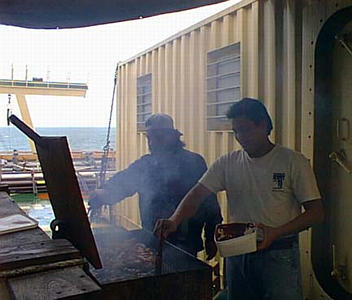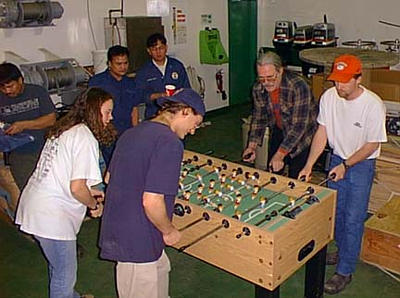
|
|
24 March, 1999
March 24, 1999
Greetings from the Strait of Magellan! We entered the strait at about 6:30
tonight . . . so we are now in a narrow body of water connecting the
Atlantic and the Pacific oceans that cuts across the bottom tip of South
America. We are going from the east toward the west (in other words, we
entered from the Atlantic Ocean). As I look outside (it's 9:30 at night,
so it's dark out), I can see the lights of several oil rigs in the
distance. Earlier, while it was still light, I could actually see land.
It's really weird to think that we are already in South America. We are
scheduled to pick up our Chilean pilot to drive the ship through the
narrowest part of the Strait of Magellan at about 2:30 in the morning. He
will remain with us for the final 80 miles as we drive into Punta Arenas.
We'll be in P.A. sometime tomorrow morning, after breakfast.
Speaking of meals, we had a great dinner tonight! It was a BBQ! If you
remember, we had a few BBQs cancelled while we were down in Antarctica due
to poor weather. Well, tonight the weather was great. It was fairly warm
(about 50 degrees . . . which is warm compared to Antarctica), and they
cooked hamburgers, hot dogs, and chicken on the grill out on the helodeck.
Although it was sprinkling a little bit, a tarp was hung to provide
protection for the grill (and the cooks). We ate inside the helicopter
hangar, which protected us from the wind and the rain (it was kind of like
eating inside a garage with the garage door open). It was a lot of fun,
and the food tasted great! We brought a CD player out so that we could
listen to some music, and there was a foosball game that a lot of people
enjoyed playing. After the dinner, several of us went up and watched a
movie in one of the lounges.
Let's take a few minutes to look at our question for today, "How are
Chinstrap and Gentoo penguins different from the Adelies and Emperors that
I saw earlier on the trip?" Although all four of these penguin species are
considered the most southern of all penguins, only Adelies and Emperors
actually breed on the continent itself. Chinstrap and Gentoo penguins both
penetrate south of the Antarctic Convergence, but their breeding grounds
are further to the north. Chinstraps breed on the islands around the
continent and some are found on the islands close to the Antarctic
Convergence. Gentoos have a wider range than Chinstraps, and they can be
found between 52 degrees South latitude in the Falklands and 65 degrees
South latitude on the frozen Antarctic Peninsula.. Gentoos that live in
the more southerly latitudes tend to be smaller in size, and they also have
smaller bills, flippers, and feet. This is probably an adaptation to the
colder climate.
Chinstrap, Gentoo, and Adelie penguins all belong to the Pygoscelis genus
of penguins, which means brush-tailed or long-tailed penguins. Of the
three species, the Gentoos have the most prominent tails, in which long,
stiff feathers stick out behind as they walk. All three of these species
are about the same size, which is nearly 30 inches tall. Gentoos have a
white front and a small white triangle above each eye, but the rest of
their body is black. Their feet are yellow-orange, and their bill is
reddish-orange. Gentoos eat a varied diet of fish and crustaceans, with
the northern animals eating mostly fish and the southern ones eating mostly
crustaceans such as krill. Depending on where they live, Gentoos build
their nests of stones, moss, and/or seaweed. Normally the female lays two
eggs in her clutch, but usually only one chick survives to fledge. Gentoos
are the least abundant of the Pygoscelis penguins . . . with only 300,000
to 350,000 individuals.
Chinstrap penguins look like they are wearing a white mask over their eyes.
They have a white chin and a white front; and they have a black head, back,
bill, and eye-ring. They also have a narrow band of black that outlines
their "mask" and goes all the way around under their chin (hence, their
name). Their eyes are reddish-brown, and the color of their feet varies
from pale flesh to yellow-orange. Chinstraps always nest on rocky ground,
and they build their nests out of pebbles. As with most penguin species,
Chinstraps must guard their nests, or their neighbors will steal stones if
given the opportunity. Chinstraps have a diet that is almost entirely
crustacean, and their population seems to be increasing in numbers. There
are now over seven million pairs of Chinstrap penguins. Some scientists
think that this increase might be a result of the decline in the number of
plankton-feeding whales.
So, what species of penguin can be found in southern Chile? We'll look at
that in tomorrow's journal. I will continue sending journals for another
two days (provided we are still able to send and receive email). Wednesday
will probably be the last day that my email is forwarded from my
<kgiestin@fayette.k12.in.us> account. After that, any mail sent to me at
that address will be waiting for me when I return home. If you want to
reach me on the ship, my ship email address is <giestiki@nbp.polar.org>. I
will post one last journal entry on Sunday, when I will be letting you know
about my final flight home as well as writing my own reflections about this
wonderful expedition. If you get a chance, I would really appreciate it if
you would take the time and sign the guest book at my school's web site.
If you are reading this journal from the TEA (Teachers Experiencing
Antarctica and the Arctic) web site, click on the button "See Kim's journal
with added links" in order to get to my school's web page. The guestbook
can be found at the top of the calendar page. If you have a class of
students that are following along on this journey, please include the grade
level(s) of your classroom, the name of your school, and your location
(city, state).
Kim Giesting
Latitude: 52 degrees 26 minutes South
Longitude: 68 degrees 46 minutes West
Temperature: 9.4 degrees Celsius
Barometer: 1006.2 mb
Wind Speed: 31.7 knots
Wind Direction: 213 degrees (from the Southwest)

Ric and Ricky are grilling our dinner on the helodeck.

Dr. Anderson is filling his plate.

Hannah, Broxton, Don, and Jesse are playing foosball while Sam, Ogie, and Ben are waiting for their turn.
Contact the TEA in the field at
.
If you cannot connect through your browser, copy the
TEA's e-mail address in the "To:" line of
your favorite e-mail package.
|
